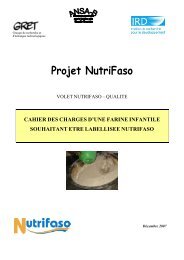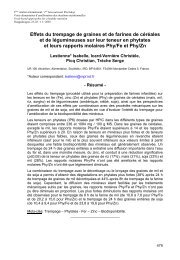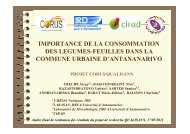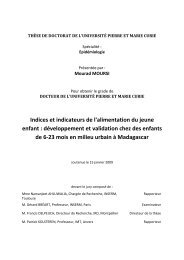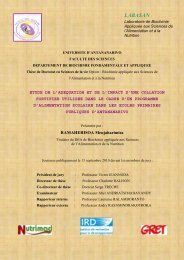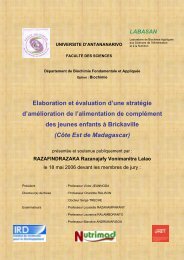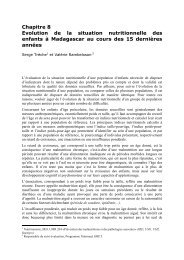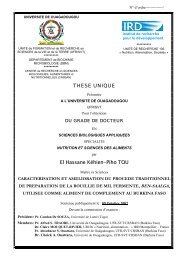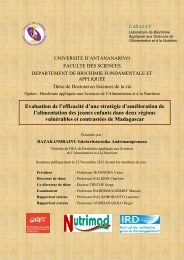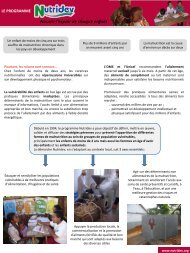into ben-saalga, a fermented gruel from Burkina Faso - Nutridev
into ben-saalga, a fermented gruel from Burkina Faso - Nutridev
into ben-saalga, a fermented gruel from Burkina Faso - Nutridev
- No tags were found...
You also want an ePaper? Increase the reach of your titles
YUMPU automatically turns print PDFs into web optimized ePapers that Google loves.
Food processing at household and community levelMATERIAL AND METHODSObservations and sampling in producing units24 producing units of <strong>fermented</strong> <strong>gruel</strong>s (<strong>ben</strong>-<strong>saalga</strong> and <strong>ben</strong>-kida) have beenrandomly selected <strong>from</strong> a list of 93 units identified one year before (1999) during apreliminary survey on the production, commercialisation and consumption of <strong>ben</strong><strong>saalga</strong>in Ouagadougou 2 .To describe the different steps of the processing and characterise the variability of theresulting product, the following measurements were performed in the producing units:duration of each step; weighing of raw material used (grains, other ingredients, water),intermediary products, waste and final products; measurement of pH. Samples ofproduct at the different stages were taken and freeze-dried for further analysis.Fermentation kineticsSince producing units were at the family scale, access to the different stages of theprocessing was not always easy, mainly for operations occurring overnight, whichillustrates the limit of the approach as indicated in the introduction. Thus fermentationkinetics during soaking and settling were investigated by reproducing field conditionsbased on survey data and described here (tables 1 and 2). Experiments wereperformed at the University of Ouagadougou at ambient temperature, using identicalrecipients to those used by the producers. For soaking, five independent pilot scaleexperiments were performed. For settling, three series of independent triplicateexperiments were performed. Grains for the soaking experiment and non <strong>fermented</strong>paste for the decantation experiment were bought <strong>from</strong> 3 different producers.Analytical methodsPhytate (IP6) content was determined on freeze-dried samples by HPIC using anOmnipac Pax-100 anion-exchange column 3 .Lactic acid, acetate, ethanol in supernatants <strong>from</strong> the soaking and settling steps wereanalysed by HPLC using an Aminex HPX-87H column, and mono- and disaccharideswere analysed by HPIC using a Carbopac PA1 column 4 .Crude protein (Nx6.25) was determined by the Kjeldahl’s method.Table 1: Amount of material and water used at the different steps of processing toprepare <strong>ben</strong>-<strong>saalga</strong>.440Mean sd* Median Min Maxpearl millet (kg) 6.6 3.9 5.9 1.8 18.1water for washing (l) 12.5 10.5 10.3 0.0 39.2water for soaking (l) 8.9 4.2 8.8 3.3 15.3ground millet (kg) 10.5 4.6 10.8 4 17.1water for grinding (l) 5.7 4.9 5.0 0.0 20.3wet dough (kg) 12.8 7.7 10.9 1.9 32.3water for sieving (l) 39.3 22.7 31.8 9.9 106.9Supernatant of the sieving step used for cooking (l) 23.9 11.1 24.3 5.1 46.8<strong>fermented</strong> paste used for cooking (kg) 9.1 3.8 9.7 2.6 15.3water added during cooking (l) 13.4 9.8 13.3 0.0 31.7*standard deviation.
Transformation des aliments au niveau des ménages et des communautésTable 3: Main chemical changes occurring during the processing of pearl millet <strong>into</strong><strong>ben</strong>-<strong>saalga</strong> (results are average values in g/100g DM with standard deviation inbrackets).ProteinsPhytate(IP6)Glucose Fructose Sucrose Raffinosewashed grains 10.2 (0.6) 0.67 (0.05) 0.12 (0.08) 0.08 (0.07) 1.09 (0.33) 0.48 (0.23)soaked grains 10.1 (0.6) 0.63 (0.10) 0.30 (0.20) 0.10 (0.09) 0.27 (0.17) 0.21 (0.16)non <strong>fermented</strong>paste<strong>fermented</strong>paste8.7 (1.2) 0.51 (0.13) 1.36 (0.56) 0.31 (0.20) 0.03 (0.02) 0.04 (0.05)6.0 (2.1) 0.18 (0.12) 0.23 (0.59) 0.05 (0.05) 0.01 (0.01) 0.08 (0.27)Fermentation kineticsDecrease of pH during soaking and settling led to investigate the kinetics of productformation in order to better characterize these steps.Surprisingly, the soaking step is characterised by a higher production of ethanol thanlactic acid (figure 2A). In contrast, as expected <strong>from</strong> the low final pH observed, thedecantation step is dominated by lactic acid fermentation (figure 2B). Production ofethanol is also observed with traces of acetate. It has to be emphasized that lacticacid formation showed a large variability as indicated by standard deviations(figure 2B), whereas ethanol and acetate concentrations did not vary so much.Variability in lactic acid production demonstrates the need to establish conditionsallowing controlling the process and reducing the extent of variability. Such a controlwould be important to produce <strong>gruel</strong>s with more defined characteristics.A6050mmol/l40302010EthanolAcetateLactate00 5 10 15 20 25 30 35 40Time (h)B70.060.050.040.030.020.010.00.00 5 10 15 20 25 30Time (h)LactateEthanolAcetateFigure 2: Fermentation kinetics during the soaking (A) and settling (B) steps of theprocessing of pearl millet <strong>into</strong> <strong>ben</strong>-<strong>saalga</strong> (Y-axis in mmol/l; bars are standarddeviations).443
Food processing at household and community levelSamples taken in different producing units at the soaking and settling steps are beinganalysed in order to establish comparisons between the experimental data and fielddata.CONCLUSIONProcessing of pearl millet <strong>into</strong> <strong>ben</strong>-<strong>saalga</strong> involves two fermentation steps: soakingand settling. Whereas the soaking step seems dominated by an alcoholicfermentation, fermentation kinetics experiments show that a lactic acid fermentationoccurs during the settling step, contributing to impart some natural protection againstfood-borne pathogens.Levels of antinutritional factors, such as phytates and raffinose are naturallydecreased during fermentation. However, considering the low energy density andprotein content of <strong>ben</strong>-<strong>saalga</strong>, additional improvements are necessary to producecomplementary foods with appropriate characteristics. Energy density can beincreased by adding α-amylase sources (e.g. malt); lipid and protein content can beimproved by co-fermentation with beans and pulses.REFERENCES1. Steinkraus KH. Handbook of indigenous <strong>fermented</strong> foods. New York: MarcelDekker, 1995:211-64.2. Djossou VA. Etude de la production, de la commercialisation et de laconsommation des bouillies à base de petit mil fermenté à Ouagadougou, <strong>Burkina</strong><strong>Faso</strong>. Mémoire de DESS Industries Agro-Alimentaires. Ouagadougou: Universitéde Ouagadougou, 2000.3. Talamond P, Doulbeau S, Rochette I, Guyot JP, Trèche S. Anion-exchange highperformanceliquid chromatography with conductivity detection for the analysis ofphytic acid in food. J Chromatogr A 2000;871:7-12.4. Calderon M, Loiseau G, Guyot JP. Nutritional requirements and simplifiedcultivation medium to study growth and energetics of a sourdough lactic acidbacterium Lactobacillus fermentum Ogi E1 during heterolactic fermentation ofstarch. J Appl Microbiol 2001;90:508-16.Acknowledgments: This work was funded by the European Commission contract N° ICA4-CT-2002-10047 (www.mpl.ird.fr/cerefer/).444



